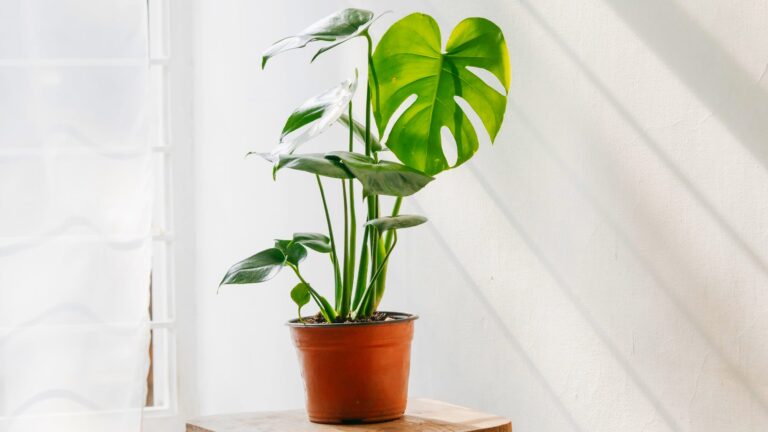Introduction
A monstera pot plays a major role in the health, growth, and beauty of your monstera plant. Whether you have a Monstera Deliciosa or a Monstera Adansonii, choosing the right pot helps the plant grow stronger roots, maintain proper moisture, and develop large, healthy leaves. Many people focus on soil and watering but forget that the pot itself affects how well the plant survives. This article explains everything you need to know about selecting the perfect monstera pot, including size, material, drainage, repotting, and long-term care.
Why the Right Monstera Pot Matters
A monstera pot is not just a container. It supports the plant’s roots, controls moisture levels, and affects how nutrients move through the soil. Monsteras naturally grow in tropical forests where their roots have plenty of airflow. A pot that is too small, too deep, or without drainage can stop airflow and cause root rot. The right pot keeps the plant stable, encourages growth, and prevents common problems like yellow leaves, slow growth, and soggy soil.
Choosing the Right Pot Size
Size is the first thing to consider. A monstera pot should be slightly larger than the root ball. If the pot is too small, roots get crowded, and the plant becomes root-bound. If the pot is too big, the soil stays wet for too long. The ideal pot is usually two to three inches larger in diameter than the current pot. Younger monstera plants can be repotted every one to two years, while larger, mature monsteras may need repotting every two to three years.
Best Pot Materials for Monstera Plants
Different pot materials benefit the plant in different ways. Clay or terracotta pots are excellent for monsteras because they allow the soil to dry faster and improve airflow. These pots are heavier and help support larger plants. Plastic pots are lightweight and hold moisture longer, which is helpful in dry environments. Ceramic pots look attractive and add stability but should always include drainage holes. Fabric pots are also becoming popular because they prevent root circling and improve oxygen flow.
Importance of Drainage Holes
Drainage is the most important feature of any monstera pot. Without drainage, excess water collects at the bottom and leads to root rot. A good monstera pot has at least one large hole or several smaller holes to allow water to escape. If you use decorative pots without holes, you can place a plastic nursery pot inside and remove it when watering. Proper drainage keeps the roots healthy and prevents fungal diseases.
Repotting Your Monstera Plant
Repotting is essential for the long-term health of your monstera. When the plant becomes root-bound or starts pushing roots through the drainage holes, it is time to upgrade the pot. To repot, gently remove the plant, loosen the roots, and place it into a slightly larger pot with fresh soil. Repotting helps the plant absorb nutrients better and encourages new leaf growth. Spring is the best season for repotting because the plant is in its active growth phase.
Signs You Need a New Monstera Pot
There are clear signs that your monstera needs a new pot. These include roots growing out of the bottom, soil drying too quickly, slow growth, or a pot that becomes unstable from the plant’s weight. If the pot cracks or becomes too small to support the plant’s heavy leaves, repotting becomes necessary. Monsteras grow quickly, so checking the pot every few months helps you avoid stress on the plant.
Watering Tips Based on Pot Type
Your monstera pot affects how often you need to water your plant. Terracotta pots dry faster, so they may need more frequent watering. Plastic pots hold moisture longer, so the soil stays wet for a longer time. Always water when the top layer of soil feels dry, not on a fixed schedule. Understanding how your pot retains moisture helps you avoid overwatering and keeps the plant strong and healthy.
Supporting Your Monstera in the Pot
Large monsteras benefit from extra support such as moss poles or stakes. These supports help the plant climb and grow upright, preventing the pot from tipping over. When choosing a monstera pot, make sure it is sturdy enough to hold both the plant and the support structure. A heavier pot or wider base works best for tall, mature plants.
Long-Term Pot Care and Maintenance
Maintaining your monstera pot is just as important as choosing it. Clean the pot during repotting to remove salt buildup and old soil. Check drainage holes regularly to ensure they are not blocked. Choose a pot saucer to protect floors but empty it after watering to avoid standing water. A clean and well-maintained pot keeps your plant healthier and reduces the risk of pests.
Conclusion
Choosing the perfect monstera pot makes a big difference in how well your plant grows. The right size, good drainage, proper material, and timely repotting all work together to support strong roots and vibrant leaves. With the proper pot, your monstera will grow beautifully, stay healthy, and become a stunning centerpiece in your home. By understanding the needs of your plant and selecting a pot that matches those needs, you ensure long-term success and strong growth for your monstera.


